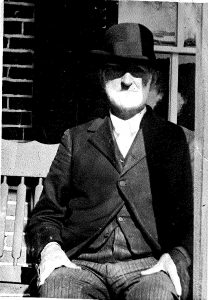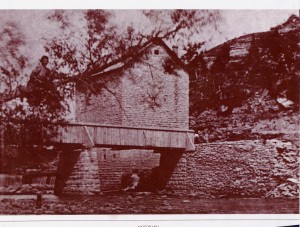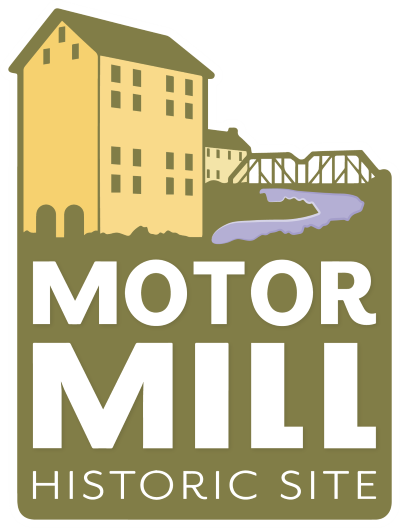Early History
Since some of what has been written and told about Motor is lost, as well as some equipment and techniques, it is challenging for us to understand in the 21st century. We are also motivated to separate the facts from the myths.

Though entrepreneur John Thompson was the initial dreamer and half owner of Motor, the specifics of Motor’s construction and operational timeline came mainly from James Crosby. Crosby was a self-employed attorney, who surveyed the site for the mill, dam, mill race, bridge, town site and railway. He also did engineering work for the mill, started a school, unsuccessfully applied for a post office and contributed financially as a quarter owner of the enterprise. The third partner was J.P Dickinson. Dickinson owned a quarter interest in Motor Mill and is believed to have been an on-site manager of the flour mill in addition to his investment in the mill and the town.
Stone for the construction was quarried from atop the bluff north of the mill. The stone was lowered down in a specially designed cable car system that Crosby engineered. Two cars ran on wooden rails, the full car carrying 3-5 tons of stone would pull the empty car up the hill as it was lowered to the building site. Crosby’s journal states the first load of rock was hauled down from the quarry on April 28, 1868.
Skilled German stonemasons from nearby communities were hired to build the mill. “Stone was dressed more carefully for it than had been other mills and laid with greater pains and precision.” Local legend told of 4 different lead masons, each responsible for one wall of the mill and each tried to outdo the others with his own style of stonework as an explanation as to why the stones on three sides of the mill have rounded faces and the fourth side, square faces.
Research has provided the real reason for the flat 4th wall. In the summer of 1869, before the flour mill was complete, Crosby and Thompson tried to promote a woolen mill at the Motor town site. Crosby traveled around the nearby countryside, promoting this venture. Written promotional items indicated that the woolen mill was to be built next to the gristmill. The flat wall of the gristmill would butt up against the wall of the planned woolen mill. In this way the two mills would share the same raceway and water to drive the water turbines for both mills.
However, Crosby and Thompson never found an investor and so the woolen mill was never built. This is most likely the real reason for the flat wall of the mill, especially since all designs we’ve understood at Motor had a practical purpose behind them. Efficient function and planned uses ranked ahead of decoration and style, although beauty was incorporated into form with paint, carved wood and stone.
Motor Mill was completed in December of 1869 and officially opened January of 1870. The mill produced excellent flour but the business suffered as chinch bugs ate wheat crops and area mills competed for fewer raw materials. When high water prevented completion of a narrow-gauge railroad for easier transportation, the young, expensive mill strained, until “some trouble occurred at the mill” and ¼ partner J.P Dickinson sold his interest to Thompson. Dickinson and his family left Motor on a February night in 1878. In 1879, the mill was rented out by Theodore Ponsar and a nephew Gilbert Thompson who worked hard to generate new business to Motor, bosting 30 barrels a day production in 1880. The final blow occurred in 1883, when a flood made the dam unusable. The dam was not repaired and the mill closed after just 14 years of operation.
According to Crosby, farmers turned from wheat and “began raising corn, cattle and hogs instead, even creameries sprang up. Railroads were beginning to haul produce away from the near-at-home market.” The mill never recouped its founders' investments but remains a striking monument to 19th century engineering skill, craftsmanship and vision.
The Motor Mill property was purchased by the Klink family in 1903 and they used the structures as farm buildings for the next 80 years.
Bridge

The original bridge at Motor was a high-sided wooden structure built in 1868. According to John Thompson’s request for bids, the bridge had three 54 foot spans 16 feet wide. The north and south end had a 15 foot approach made of timber and plank. The three spans were Howe Truss and the 5 or 6 foot high wooden sides were simply added to enclose the trusses.
A Pin Connected Pratt Through Truss steel bridge was built at Motor in 1899. The bridge had two 95 foot spans with a 16 foot wide wood deck. In June of 1991 flood waters destroyed the south span. The span was not replaced due to low traffic counts and the historic nature of the bridge. The north span was then destroyed by the flood of 2008.
There was a great desire to rebuild the bridge and so the project began in earnest. Types of expenses to rebuild the bridge included construction, engineering, and inspection. All of these expenses combined gave an estimated total cost of $1,069,322. The funding for the bridge reconstruction came from a number of sources. The largest amounts came from FEMA (Federal Emergency Management Agency) and REAP (Resource Enhancement and Protection). Other sources were Iowa Great Places, the Upper Mississippi Gaming Corporation, the Clayton County Engineer Office, and the Capital Fund Campaign. These funds totaled to $975,985, which left $93,347 as the remaining funds needed. This was paid for by the Motor Mill Foundation.
It took just under 2 months to complete the new bridge. Construction began on October 11, 2012 and finished on December 6, 2012. An official ribbon cutting ceremony was held a few days later on December 8, 2012. The new bridge has been very well received by the community as well as many other patrons who enjoy visiting the Motor Mill site. Support only continues to grow as tours and visits increase, with some visitors using the site as a backdrop for special moments such as wedding and senior photos!
Formation of the Motor Mill Historic Site
The Klink family understood how unique the site was and worked to have it placed on the national registry. In 1977 they succeeded and Motor Mill was listed on the National Register of Historic Places as Motor Mill Historic Site. The Historic Site designation was upgraded in 2014 to include the whole townsite as the Motor Mill Historic District.
In 1983 the Clayton County Conservation Board (CCCB), with help from the Iowa Natural Heritage Foundation, purchased the Motor Mill Historic Site along with 100 acres of land. The purchase included 40 acres associated with the Motor Mill buildings on the north side of the Turkey River and 60 acres on the south side of the Turkey River. The buildings consist of five native limestone buildings including a Stable, an Inn, an Icehouse, Cooperage and the 90-foot Motor Mill.
The purchase was made for the purpose of preserving and restoring the buildings, along with interpreting the history of the site. Starting in 1985, the CCCB sponsored Open Houses at the Motor Mill Site. This gave county residents and visitors a chance to see inside the buildings and learn more about the history of the site.
The Motor Mill Site was expanded in 1992. Again, with assistance from the Iowa Natural Heritage Foundation, the CCCB was able to purchase an additional 55 acres adjoining the original 40 acres on the north side of the river. The most significant part of the purchase included the original town site of Motor platted in 1875.
Today, the Motor Mill Historic Site totals 155 acres; 95 on the north side of the Turkey River and 60 acres on the south side. The CCCB maintains a hiking trail on each side of the river and a canoe ramp, campground, and picnic area on the north side.
In 2001, the CCCB received a REAP HRDP grant to write a Preservation Plan. The completed plan outlined the current conditions of the site’s primary structures. Also included in the plan were short-term and long-term recommendations for preserving the buildings.
The short-term recommendations were completed in the first year. Windows were repaired to prevent water damage and the buildings were painted and better air ventilation was provided. Long-term recommendations included major roofing issues. Many of the roofs on the buildings were in need of replacement. The plan outlined a time-line and roof type to meet National Register standards. Funding sources were pursued for this project and completed through grants and donations. Find out more on ongoing restoration projects at the Inn and Stable click here.

Co-founder James Crosby said it best when he described the Mill as being, "Beautiful in its proportions, solid as the rock from which it was made, the old mill stands in white relief against the forested hills, a delight to the eye in its perfection and its picturesque setting.”
Click here to read our most current newsletter for up to date information on the Motor Mill site!
